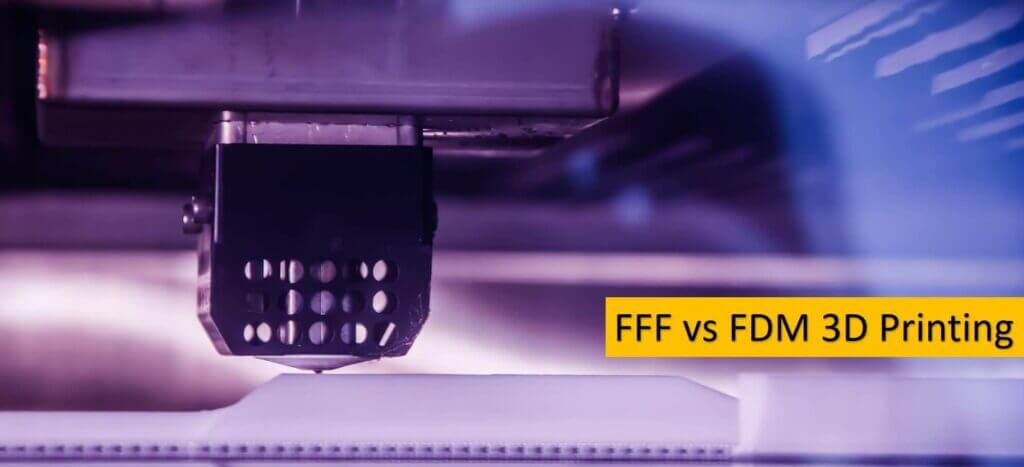Both fused filament fabrication (FFF) and fused deposition modeling (FDM) 3D printing technologies create parts or prototypes using the material extrusion method of additive manufacturing. Each of these 3D printing machines forms solid three-dimensional items by depositing melted thermoplastic filament onto a build platform layer by layer.
That is why; many bloggers use the terms FDM and FFF interchangeably while describing 3D printing technologies. But you must remember that the 3D printing technologies differ from each other in many aspects. For instance, FDM is a widely used industrial-grade 3D printing technology, while FFM is popular with students, hobbyists, and novice users.
While comparing FFF vs FDM 3D Printing, you must remember that each of these 3D printing technologies has its pros and cons. Hence, you must understand the FFF and FDM 3D printing processes individually. At the same time, it is also important to keep in mind the similarities and differences between FDM and FFF 3D printing technologies.
FDM 3D Printing Technology
FDM was launched as a proprietary 3D printing technology by Stratasys in 1989. FDM 3D printers are designed with print chambers as the core part. Engineers heat the entire print chamber during the 3D printing process. The heating of the entire heat chamber eliminates the temperature fluctuations and reduces warping.
Hence, a part produced using FDM 3D printing technology comes with additional strength, high resolution, smooth finish, and predefined mechanical properties. However, FDM 3D printers are complex and demand more power. They are mostly used for industrial projects and operated by trained technicians.
FFF 3D Printing Technology
The members of the RepRap community launched FFF 3D printing technology after Stratasys’s patent on FDM expired in 2009. In addition to being a simplified version of FDM, FFF fuses thermoplastic filaments using an electron beam. Hence, FFF 3D printers do not feature an isolated heat chamber.
Instead, they are designed with extruder nozzles with the capability to extrude filaments with higher temperatures and pressure. Also, FFM machines are smaller, cheaper, and more energy-efficient than FDM 3D printers. Hobbyists, students, and beginners find FFF 3D printers affordable.
But FFF does not produce high-quality parts like FDM. Also, warping is one of the key issues in FDM 3D printing technology. The absence of the heating chamber often impacts the environment by producing foul-smelling fumes. That is why; enterprises prefer FDM to FFF when creating functional parts and product prototypes.
FFF vs FDM 3D Printing Technology
Isolated Print Chamber
An isolated print chamber is one of the key components that make FDM 3D printers different from and superior to FFF 3D printers. As the name suggests, the print chamber remains separated or isolated from the environment during the FDM 3D printing process. But it makes the filament flow from the extruder to the build platform in a heated environment.
The isolated print chamber improves print quality by increasing layer adhesion, preventing warping, and keeping the filament’s mechanical property intact. FFF 3D printers are not designed with heated print chambers due to copyright restrictions. The absence of the print chamber keeps FFF 3D printers portable. But they produce parts or models of inferior quality.
Build Volume
FDM 3D printers are designed as large enclosed machines. They provide build space ranging from 305 x 305 x 254 mm (X-Y-Z) up to 914 x 914 x 609 mm. Also, the machines can withstand higher mechanical loads. FFF machines provide build space ranging from 150 x 150 x 150 mm to 600 x 600 x 600 mm. That is why; enterprises prefer FDM to FFF while producing large functional parts and engineering-grade prototypes.
Accuracy Level
In addition to supporting larger build volumes, FDM 3D printers produce parts with a dimensional accuracy of ± .127 mm. They further complement the high-level dimensional accuracy with consistent print quality. FFF 3D printers do not produce parts with a lower level of dimensional accuracy. Hence, they are not used for commercial projects.
Surface Quality
Enterprises use finer filament feedstock while creating parts or prototypes using FDM 3D printers. Hence, the parts come with a superior surface finish. But FFF 3D printers do not fuse the layers seamlessly. Hence, the parts produced using a FFF 3D printer comes with lower resolution and an unimpressive surface finish.
Model Materials
While using FFF 3D printers, hobbyists curtail costs by opting for inexpensive thermoplastic materials. But enterprises use stronger plastic materials like Nylon, Polycarbonate, PEE, and ULTEM in the FDM 3D printing process. Also, they boost filament quality using a laser during the printing process. That is why; the parts produced using FDM 3D printing technology are stronger enough to complement the needs of various engineering projects.
Support Materials
FDM simplifies post-processing using soluble support materials. Engineers can separate the support material from the 3D-printed parts easily by placing it inside a heated ultrasonic tank. Hence, they can remove the support material without impacting the print quality.
Polyvinyl alcohol (PVA) is used by most FFF 3D printers as a support material. The water-soluble material is fully compatible with PTA. But the material does not work well with other FFF 3D printing materials like ABS and PC. Hence, hobbyists have to put in extra time and effort to separate support material accurately while using FFF 3D printers.
Use Cases
As noted earlier, FDM is an industrial-grade additive manufacturing technology. Companies and startups from various sectors use FDM 3D printers to create a variety of end parts and product prototypes. But FFF is a desktop 3D printing technology. Students and hobbyists use FFF 3D printers to produce home decors, gift items, and similar products from CAD files created by them.
Printing Costs
FDM 3D printers are larger and more complex than FFF 3D printers. These expensive 3D printing machines are used mostly by enterprises. Its affordable price makes FFF 3D printers hugely popular with students, hobbyists, and novice users. But many users curtail project costs by availing of customized FDM 3D printing services provided by various companies and startups.
FFF vs FDM 3D Printing: Conclusion
FDM is an industrial-grade 3D printing technology, while FFF is a desktop 3D printing technology. Hence, you must use your precise project needs as the primary parameter for comparing these widely-used additive manufacturing technologies. At the same time, you must keep in mind the pros and cons of both FDM and FFF to choose the perfect 3D printing technology for your next project.
About Aurum3D
We are amongst the major 3D printing companies in Bangalore, India. We have been providing SLS, SLA and custom FDM 3D printing services to many major industries. Please feel free to get in touch with us for your custom needs, our 3D printing solutions experts will get back to you within one business day.

